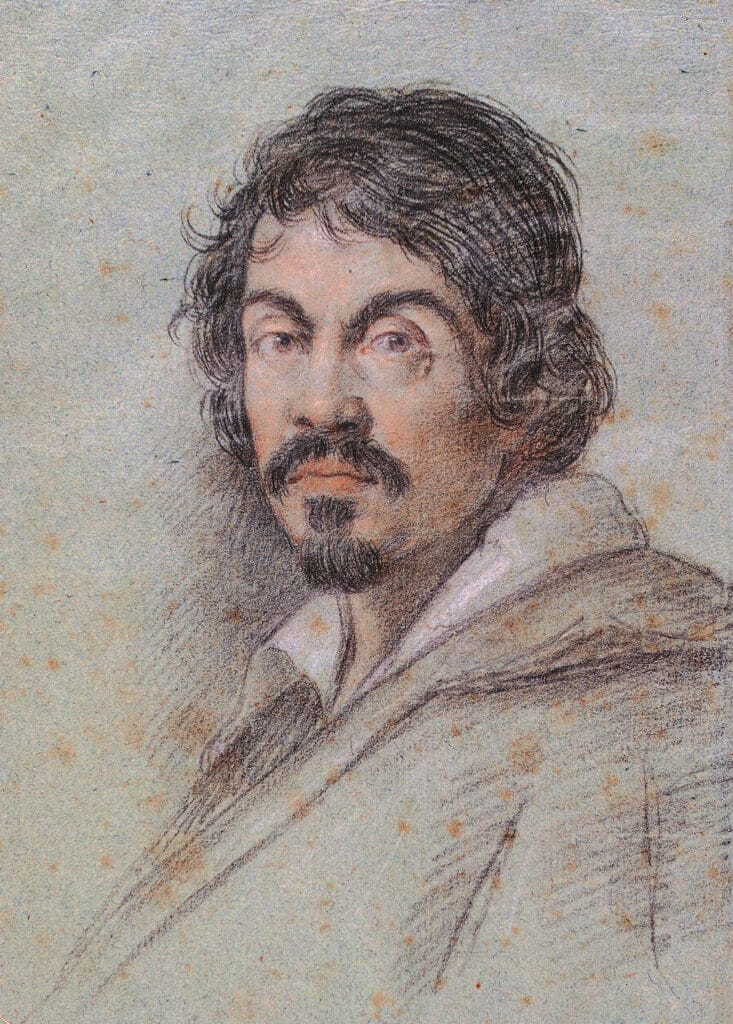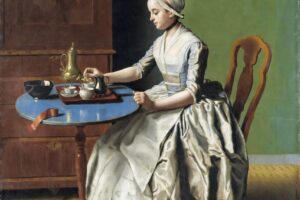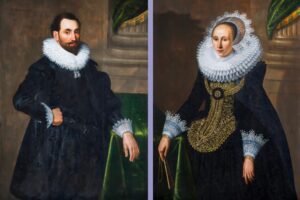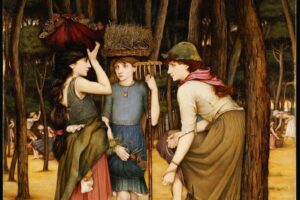The Cardsharps – Caravaggio, 1594
A quiet room, a game of cards, and a tense silence humming beneath the surface. Painted in 1594 by Caravaggio, The Cardsharps is a vivid portrayal of youthful innocence confronted by cunning deception. Caravaggio, a master of dramatic realism and psychological insight, uses this moment to explore themes of trust, betrayal, and the fragile innocence of youth.
The Scene Before Us
At the left, a youthful boy—naive and earnest—is deeply absorbed in the cards he holds. His dark velvet tunic and simple, elegant hat underscore his privileged yet vulnerable position. His eyes, locked in concentration, betray no awareness of the danger lurking in plain sight. Before him rests a backgammon board, an idle detail overshadowed by the intensity of the unfolding drama.
Behind him stands an older man, imposing and richly dressed, his feathered hat and intricately patterned doublet hinting at authority. His shadowed face leans close, eyes cunningly observing the innocent boy’s cards. His gloved hand subtly gestures to the third participant—a silent directive of deception, carefully orchestrating a scheme hidden beneath polite society’s veneer.
Facing the unsuspecting youth is another young man, brightly attired in a vibrant yellow and black striped vest. With a sword at his side and a feathered cap atop his head, he too embodies elegance and poise, yet carries something sinister. Hidden discreetly behind his back, extra cards await their moment. His posture conveys confidence and cunning, fully aware of his role in this silent betrayal.
The Deeper Meaning
Caravaggio presents more than mere trickery—he captures a universal human drama. Through intense contrasts of light and shadow, he highlights innocence and deceit, trust and treachery, honesty and manipulation. The painting is a metaphorical dance of opposing forces, a powerful reflection on vulnerability and the calculated exploitation of trust.
Each character represents a facet of human nature: innocence, cunning, and calculated manipulation. Caravaggio does not openly judge his figures; instead, he invites viewers into a nuanced reflection. We sympathize with innocence, yet recognize in ourselves the potential for cunning. The painting asks quietly: Who are we in this delicate interplay?
A Moment Caught in Time
Caravaggio’s dramatic lighting and meticulous composition freeze this pivotal moment, balancing tension and stillness. The simplicity of the dark background further intensifies our focus on the human drama unfolding at the table, revealing layers of psychological complexity beneath the seemingly straightforward scene.
In this quiet game of cards, Caravaggio portrays life’s ever-present tension between vulnerability and deceit, innocence and experience. He gently reminds us that we must remain vigilant—not only of others, but also of ourselves.
About Artist

Michelangelo Merisi da Caravaggio (1571–1610) was an Italian painter who single-handedly revolutionized painting and became a pivotal figure of the Baroque art movement. Living a tumultuous and often violent life, he created a body of work that was both intensely realistic and profoundly dramatic. His radical approach broke away from the idealized forms of the Renaissance and Mannerism, influencing a generation of artists known as the Caravaggisti.
Artistic Innovations
Caravaggio’s genius lies in his revolutionary use of a technique now known as tenebrism. This is an extreme form of chiaroscuro that uses a dramatic, single light source to create stark contrasts between light and dark, plunging the background into deep shadow while illuminating the figures in a theatrical spotlight. This technique heightens the emotional intensity of his scenes.
He also shocked his contemporaries with his radical naturalism. Unlike artists who used idealized models, Caravaggio often painted directly from life, using real people—including beggars, laborers, and prostitutes—as models for his saints and biblical figures. This brought a new, raw, and often shocking level of humanity to religious subjects. His paintings feel immediate and tangible, as if the sacred events are unfolding in a contemporary, ordinary setting.
Notable Works
- “The Calling of Saint Matthew” (1599–1600): This masterpiece, housed in the Contarelli Chapel in Rome, is a perfect example of his style. A single ray of light from an unseen source illuminates the tax collectors in a dark room as Christ, on the right, calls Matthew to follow him. The scene feels less like a historical event and more like a pivotal, everyday moment.
- “Basket of Fruit” (c. 1599): A truly groundbreaking painting, this is one of the earliest examples of a stand-alone still life in Italian art. Rather than depicting perfect, idealized fruit, Caravaggio rendered the basket’s contents with unflinching realism, including wormholes in an apple and a shriveled leaf. This work is often interpreted as a “memento mori,” a reminder of the transience of life and the inevitability of decay.
- “Judith Beheading Holofernes” (c. 1599): This intensely violent and psychological painting depicts the biblical heroine Judith in the act of beheading the Assyrian general. The scene is full of drama and emotion, with Judith’s face conveying a mixture of determination and revulsion.
- “The Supper at Emmaus” (1601): This work captures the moment the disciples recognize the resurrected Christ. The gestures are explosive, with one disciple’s arms outstretched in shock. The illusion of a meal on the table, with a basket of fruit seemingly about to topple off, brings the divine event into the viewer’s immediate space.
- “The Entombment of Christ” (1602–1603): Considered one of his greatest masterpieces, this painting focuses on the raw grief of those lowering Christ’s body into the tomb. The light, the weight of the bodies, and the powerful expressions of sorrow create a moving and unforgettable devotional image.
This Painting, The Calling of Saint Matthew, is Featured in ( Baroque Spot the Difference Puzzles : Interactive, Printable Flipbook) by Classic Art Puzzles.
About Artist



